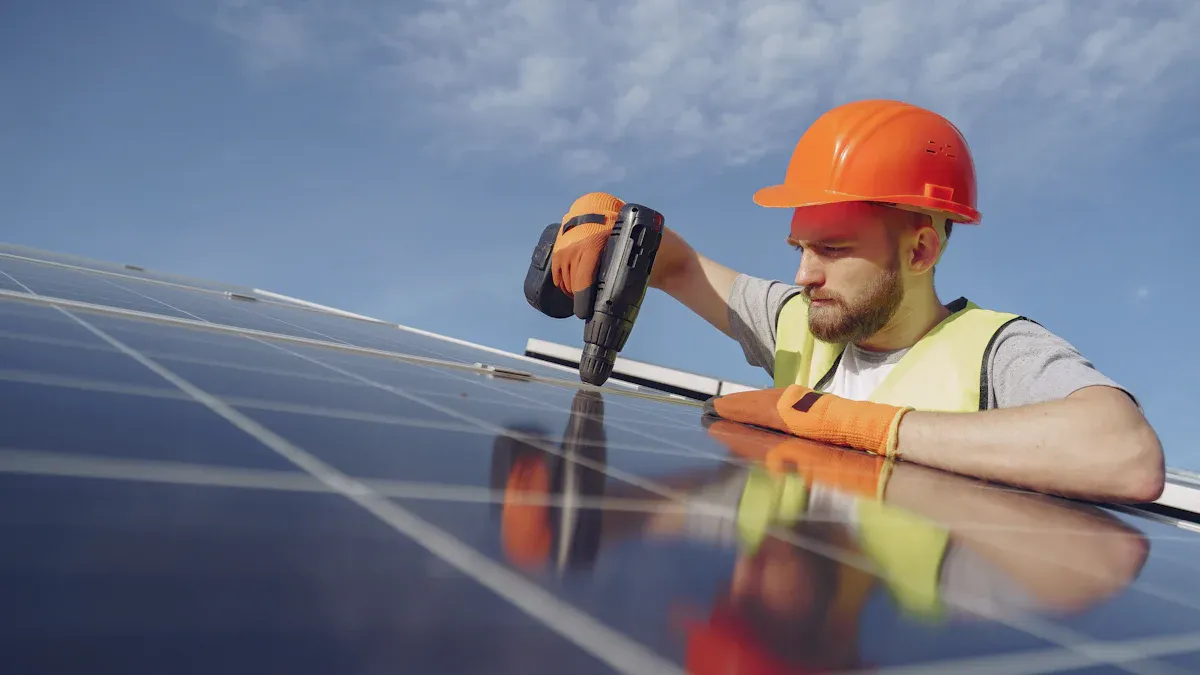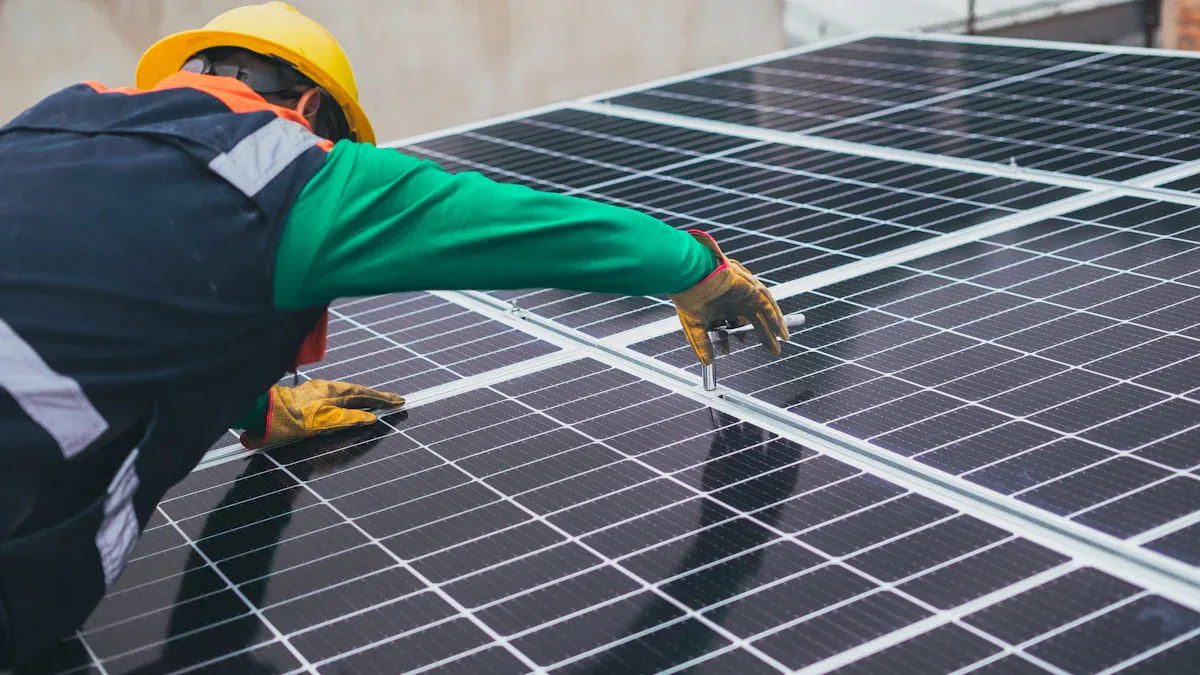5 Easy PV Panel Fixes for Telecom Cabinets

Here are five easy fixes you can apply to your telecom cabinet’s PV panel system:
Adjust panel placement for maximum sunlight.
Clean panels and set a simple care routine.
Check all connections and secure loose wires.
Integrate backup batteries for steady power.
Use monitoring tools to track performance.
Many telecom cabinets face issues such as poor wire management, missing labels, and improper grounding. These problems often lead to safety risks and lower system reliability. With basic technical skills, you can handle these tasks and keep your PV panel system running smoothly, especially at remote or off-grid sites.
Key Takeaways
Place your PV panel where it gets the most direct sunlight and adjust its angle to boost energy output and system reliability.
Clean your panels regularly using gentle tools and mild soap to keep them efficient and extend their lifespan.
Check all wiring and connections often, tighten loose parts, and label cables to prevent power loss and ensure safety.
Use the right backup batteries that fit your system and environment to keep your telecom cabinet powered during outages.
Monitor your PV system with smart tools and set alerts to catch problems early and maintain steady performance.
1. PV Panel Placement

Sunlight Positioning
You can boost your telecom cabinet’s energy output by placing your PV panel in the best possible spot. Start by choosing an area with no shade from trees, buildings, or other equipment. The angle and orientation of your PV panel play a big role in how much sunlight it captures. When you tilt the panel correctly, you help it receive full sun exposure throughout the day. This step is essential for high efficiency and reliable power.
Tip: Place your PV panel where it gets the most direct sunlight, especially during peak hours. Adjust the tilt to match your location’s latitude for better results.
Improper placement can cause several problems:
You might see a drop in energy output.
The system could lose efficiency or even malfunction.
Incorrect installation may void your warranty.
Poor mounting or lack of ventilation can lead to overheating.
Regularly check your PV panel’s position and make small adjustments if you notice shadows or dirt buildup. Certified installation ensures secure mounting and proper angles, which keeps your system running smoothly.
Hybrid System Setup
Many telecom cabinets use hybrid or off-grid systems. You can combine your PV panel with other power sources, such as batteries or generators, for steady operation. When setting up outdoors, always use weather-tight cabinets to protect your equipment from rain, dust, and extreme temperatures.
Setup Step | What to Do |
|---|---|
Choose Location | Pick a spot with maximum sunlight |
Use sturdy brackets and check for stability | |
Weather Protection | Seal cabinet and use waterproof fittings |
Connect PV panel to batteries or backup |
A well-placed PV panel, combined with a hybrid setup, helps you avoid downtime and keeps your telecom cabinet working even in tough conditions.
2. Cleaning and Care

Simple Cleaning Steps
Keeping your PV panels clean helps you get the most energy from your telecom cabinet. Dirt, dust, and bird droppings can block sunlight and lower efficiency. You can follow these easy steps to keep your panels in top shape:
Use a soft brush or a microfiber cloth to remove loose dirt from the panel surface.
Mix mild dish soap with soft water or use a commercial eco-friendly cleaning agent.
Gently wash the panel using a soft-bristled brush or squeegee. Avoid using harsh chemicals or abrasive pads.
Rinse the panel with a garden hose using light water pressure (below 40 PSI). Never use strong jets that could damage the surface.
Clean your panels during early morning or late afternoon. Cooler temperatures prevent heat damage and stop water from drying too quickly.
Avoid cleaning during the hottest part of the day or under direct sunlight. Overcast days work well for cleaning.
Tip: Schedule a cleaning every six months to a year, or more often if you notice heavy dirt buildup. If your panels are hard to reach, consider hiring a professional cleaning service for safety.
Maintenance Routine
A regular maintenance routine keeps your PV system reliable and efficient. You can set up a simple checklist to make sure nothing gets missed:
Inspect your panels monthly for dirt, cracks, or signs of damage.
Check all electrical connections for corrosion or loose wires.
Record each cleaning and inspection in a logbook. Include the date, weather conditions, and any issues you find.
Plan your cleaning schedule around local weather. Clean before rainy seasons or after dust storms.
Use only soft cleaning tools and gentle techniques to avoid scratching the panels.
Wear non-slip shoes and use stable ladders or platforms for safety during maintenance.
Task | Frequency | Tools Needed |
|---|---|---|
Visual Inspection | Monthly | Flashlight, logbook |
Cleaning | 6-12 months | Soft brush, mild soap |
Connection Check | Monthly | Screwdriver, gloves |
By following these steps, you help your telecom cabinet’s PV panels last longer and work better. Regular care means fewer surprises and more reliable power for your network.
3. Connection Checks
Wiring Inspection
You need to check your wiring regularly to keep your telecom cabinet safe and reliable. Faulty or loose wires can cause power loss or even damage your equipment. Follow these steps to inspect your PV panel wiring:
Assign unique labels to each cable. This helps you verify correct connections and makes future troubleshooting much easier.
Carefully inspect all terminal connections. Make sure no wires are exposed, loosely connected, or placed in the wrong spot.
Systematically check the entire wiring. Remove any cut wire particles or foreign objects that could cause shorts.
Perform point-to-point continuity tests using your wiring schematics. This step ensures every wire connects as it should before you power up the system.
Verify proper grounding and bonding. Connect neutral wires to the neutral bus bar and ground wires to the ground bus bar for safety.
After testing, power on the panel and test each circuit one by one. Confirm that everything works and no breakers trip.
Document your wiring and inspection results. Keep diagrams, manuals, and maintenance plans for future reference.
Tip: Always follow safety protocols and use insulated tools when working inside your telecom cabinet.
Secure Connectors
Loose connectors can lead to power drops or system failures. You should check and secure all connectors during each inspection. Use these best practices:
Tighten all screw terminals and plug-in connectors. Make sure nothing wiggles or pulls out easily.
Replace any damaged or corroded connectors right away.
Label each circuit wire near its breaker or terminal. This step saves time during future maintenance.
Keep a regular schedule for connection checks.
Maintenance Task | Frequency |
|---|---|
Inspect and clean solar panels | Monthly |
Check battery health and connections | |
Test inverter and charge controller | Semi-annually |
Full system performance review | Annually |
You should perform connection checks at least every quarter. This routine helps you catch loose connections, damaged cables, or signs of wear before they cause bigger problems. Regular checks keep your PV panel system running smoothly and help prevent unexpected failures.
4. Battery Integration
Battery Selection
Choosing the right battery for your telecom cabinet ensures reliable backup power when your PV panel cannot supply enough energy. You should focus on batteries that match your cabinet’s needs and environment. Most telecom systems use 48V batteries for safety and efficiency. Lithium-ion batteries are now the preferred choice because they last longer, require less maintenance, and handle deep discharges well. Valve-regulated lead-acid (VRLA) batteries remain common due to their low cost and compatibility with standard telecom equipment.
Here’s a quick comparison to help you decide:
Battery Type | Best Use Case | Key Features for PV Integration and Telecom Cabinets |
|---|---|---|
48V Outdoor Lithium Battery | Off-grid towers, outdoors | Rugged, weather-sealed, long lifespan, remote monitoring, low maintenance |
48V Standard Rack-Mount Lithium | Indoor rooms, UPS backup | Compact, rack-mountable, reliable, space-saving, optional remote monitoring |
Smart Battery | Solar-integrated, intelligent | High energy density, remote communication, temperature control, designed for solar hybrid |
Look for batteries with:
Deep cycle capability and high cycle life
Wide operating temperature range
Maintenance-free and leak-proof design
Compliance with telecom rack sizes (19"/23")
Remote monitoring features for diagnostics
Tip: Always choose batteries that fit your cabinet’s space and environmental conditions. Outdoor batteries need weather-sealed enclosures to prevent damage.
Easy Connection Guide
You can connect your PV panel to backup batteries in a few simple steps. This setup stores solar energy during the day and supplies power during outages, keeping your telecom equipment running without interruption.
Check Voltage and Current Ratings
Make sure your PV panel, charge controller, inverter, and battery bank all match in voltage and current. Most telecom cabinets use 48V systems for safety and efficiency.Use an MPPT Charge Controller
Install a modern charge controller with Maximum Power Point Tracking (MPPT). This device optimizes energy flow from your PV panel to the battery, even when sunlight changes.Connect Components Securely
Use high-quality wiring and weatherproof connectors. Place batteries in a temperature-controlled, ventilated area inside the cabinet. Avoid direct sunlight and moisture.Verify Compatibility
Check manufacturer datasheets to confirm all parts work together. Choose inverters that match your system’s voltage and power needs. Place inverters in shaded, ventilated spots to prevent overheating.Monitor and Maintain
Use smart monitoring tools to track battery health and energy use. Regular inspections help you spot issues early and keep your backup system reliable.
Well-maintained solar-battery systems reduce downtime and support continuous telecom service, even during emergencies.
Modular setups let you expand storage as your power needs grow.
Note: Always follow safety guidelines and consult your equipment manuals before making connections.
5. PV Panel Monitoring
Monitoring Tools
You can keep your telecom cabinet’s PV system running at its best by using the right monitoring tools. These devices help you track performance, spot problems early, and make smart decisions about maintenance. Reliable monitoring systems give you consistent and traceable data, which helps you get the most out of your solar investment.
Many monitoring tools process data independently from inverters. This means you get accurate readings even if one part of the system fails.
Look for compact devices that fit easily inside your telecom cabinet. Space is often limited, so a small form factor matters.
Choose tools that protect Ethernet and communication ports. This keeps your data safe from surges or harsh weather.
The Lanner LEC-3030 gateway is a good example. It offers strong data processing, protected connections, and a design built for tough environments.
You can also use DC energy meters to measure the direct current output from your solar panels. These meters give you real-time data on how much energy your system produces. Some popular options include:
Multi-function energy meters
DC power meters
Wireless energy meters
Smart gateways
These devices help you track performance, detect faults, and calculate your return on investment. They support efficient energy management by giving you precise, timely data tailored for telecom applications.
Setting Alerts
Setting up alerts is a smart way to prevent PV panel failures. Real-time monitoring systems track voltage, current, and temperature. When something goes wrong, you get an instant notification. This lets you act fast and avoid bigger problems.
Remote access allows you to check multiple sites without being there in person. You can monitor and control your system from anywhere.
Alarm notifications warn you about issues like power failures or overheating. You can fix problems before they cause downtime.
Data logging and analysis help you spot trends. You can plan maintenance and replace parts before they fail.
Monitoring software updates improve reliability and security.
Tip: Use monitoring systems as the “brains” of your power setup. They reduce the risk of failures and help keep your telecom service running smoothly.
By using the right tools and setting up alerts, you make sure your PV panel system stays reliable and efficient. Regular monitoring helps you catch issues early and keeps your telecom cabinet powered up, even in tough conditions.
You can boost your telecom cabinet’s performance by following these five PV panel fixes:
Adjust placement for maximum sunlight.
Clean and maintain panels regularly.
Check and secure all wiring connections.
Integrate reliable backup batteries.
Monitor system performance with smart tools.
These steps help you improve reliability, reduce downtime, and save money over time. Using durable materials like ESTEL Steel for mounting structures lowers repair needs and extends equipment lifespan. Regular maintenance and protective measures also cut operational costs and prevent expensive failures.
FAQ
How often should you clean your PV panels?
You should clean your PV panels every six to twelve months. If you notice heavy dust or bird droppings, clean them sooner. Regular cleaning helps you keep your system efficient and reliable.
What tools do you need for basic PV panel maintenance?
You need a soft brush, mild soap, a microfiber cloth, and a garden hose with low pressure. For safety, use insulated gloves and a sturdy ladder. These simple tools help you maintain your panels without causing damage.
Can you use any battery with your telecom PV system?
No, you should only use batteries that match your system’s voltage and current ratings. Choose batteries designed for telecom use, such as 48V lithium or VRLA types. Always check compatibility before connecting.
What should you do if your PV panel output drops suddenly?
First, check for dirt or shading on the panel. Inspect all wiring and connectors for loose or damaged parts. If you find no issues, use your monitoring tool to check for faults. Contact a technician if the problem continues.
Do you need special software to monitor your PV system?
You do not need special software for basic monitoring. Many systems include built-in displays or simple apps. For advanced tracking, use smart gateways or energy meters with alert features. These tools help you spot problems early.
See Also
Solar Energy Storage Solutions Designed For Telecom Cabinets
Guide To Choosing And Installing Pole-Mounted Telecom Cabinets Safely
Effective Ways To Safeguard Equipment Using Outdoor Telecom Cabinets
Strategies For Maintaining Consistent Power In Telecom Cabinets
Essential Outdoor Maintenance Tips For ESTEL Telecom Cabinets
CALL US DIRECTLY
86-13752765943
3A-8, SHUIWAN 1979 SQUARE (PHASE II), NO.111, TAIZI ROAD,SHUIWAN COMMUNITY, ZHAOSHANG STREET, NANSHAN DISTRICT, SHENZHEN, GUANGDONG, CHINA


